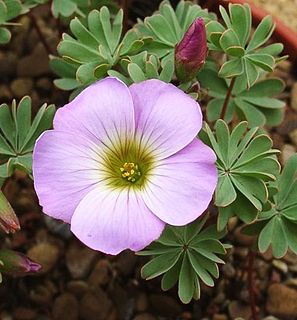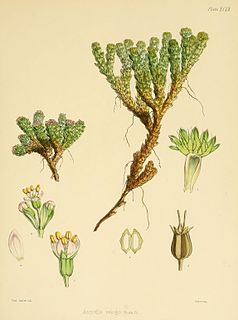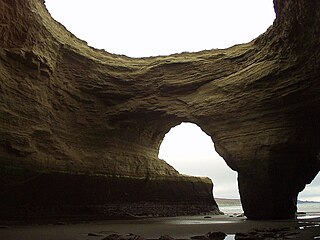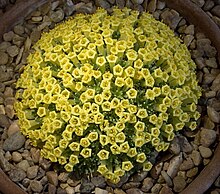
George Bentham was an English botanist, described by the weed botanist Duane Isely as "the premier systematic botanist of the nineteenth century". Born into a distinguished family, he initially studied law, but had a fascination with botany from an early age, which he soon pursued, becoming president of the Linnaean Society in 1861, and a fellow of the Royal Society in 1862. He was the author of a number of important botanical works, particularly flora. He is best known for his taxonomic classification of plants in collaboration with Joseph Dalton Hooker, his Genera Plantarum (1862–1883). He died in London in 1884.

Oxalis enneaphylla, scurvy grass, is a late spring- and summer-flowering, rhizomatous, alpine perennial herbaceous plant native to the grasslands of Patagonia and the Falkland Islands. It is a small plant that grows to 7 cm (2.8 in) high and 10 cm (3.9 in) across, with slightly fleshy, hairy, blue-grey leaves, which are edible but have a sharp taste due to their high oxalic acid content. The name enneaphylla comes from the Greek εννεα (ennea), "nine" and φυλλον (phyllon), "leaf".

Azorella is a genus of flowering plants in the family Apiaceae, native to South America, New Zealand, southeastern Australia, and the islands of the Southern Ocean.

Schizanthus, also called butterfly flower, fringeflower, poor-man's-orchid, is a genus of plants in the nightshade family, Solanaceae.

Calceolaria uniflora is a perennial plant of the genus Calceolaria, known as the slipperworts. It is originally from Tierra del Fuego in the southern part of South America.

Nassauvia is a genus of flowering plants in the Nassauvia tribe within the sunflower family. It native to Argentina, Bolivia, Chile and the Falkland Islands.

Azorella selago is a species of cushion plant native to the sub-Antarctic islands of the Southern Ocean, including the Crozet Islands, the Possession Islands, the Heard Island and McDonald Islands, the Kerguelen Islands, and the Prince Edward Islands. The closely related Azorella macquariensis, which is endemic to Macquarie Island, was split from it taxonomically in 1989. A. selago is often a keystone species where it occurs and is well studied for its contribution to its native ecosystems.

A cushion plant is a compact, low-growing, mat-forming plant that is found in alpine, subalpine, arctic, or subarctic environments around the world. The term "cushion" is usually applied to woody plants that grow as spreading mats, are limited in height above the ground, have relatively large and deep tap roots, and have life histories adapted to slow growth in a nutrient-poor environment with delayed reproductivity and reproductive cycle adaptations. The plant form is an example of parallel or convergent evolution with species from many different plant families on different continents converging on the same evolutionary adaptations to endure the harsh environmental conditions.

Salvia is the largest genus of plants in the sage family Lamiaceae, with nearly 1000 species of shrubs, herbaceous perennials, and annuals. Within the Lamiaceae, Salvia is part of the tribe Mentheae within the subfamily Nepetoideae. One of several genera commonly referred to as sage, it includes two widely used herbs, Salvia officinalis and Salvia rosmarinus.

Astelia is a genus of flowering plants in the recently named family Asteliaceae. They are rhizomatous tufted perennials native to various islands in the Pacific, Indian, and South Atlantic Oceans, as well as to Australia and to the southernmost tip of South America. A significant number of the known species are endemic to New Zealand. The species generally grow in forests, swamps and amongst low alpine vegetation; occasionally they are epiphytic.

Adesmia is a genus of flowering plants in the legume family, Fabaceae. It was recently assigned to the informal monophyletic Adesmia clade within the Dalbergieae.

Monte León National Park is a federal protected area in Santa Cruz Province, Argentina. Established on 20 October 2004, it houses a representative sample of the steppe and Patagonian coast biodiversity in good state of conservation, as well as several paleontological sites of high value. It runs along 36 km (22 mi) of the southern Argentine Sea coastline.
Mandragora caulescens, the Himalayan mandrake, is a perennial herbaceous plant in the family Solanaceae, native to the Himalayas and mountainous regions of Myanmar and south-west China. One of the differences from the other species of Mandragora is that it has a stem, whereas they are stemless. Like all species of Mandragora, it contains tropane alkaloids, making it toxic. It is used in traditional Chinese medicine.
Callianthemoides is a genus of plants in the family Ranunculaceae, with a single species, Callianthemoides semiverticillata. Native to screes in northern Patagonia, it has divided greyish or reddish green leaves and large white or pink flowers.

The Solanaceae, or nightshades, are a family of flowering plants that ranges from annual and perennial herbs to vines, lianas, epiphytes, shrubs, and trees, and includes a number of agricultural crops, medicinal plants, spices, weeds, and ornamentals. Many members of the family contain potent alkaloids, and some are highly toxic, but many—including tomatoes, potatoes, eggplant, bell and chili peppers—are used as food. The family belongs to the order Solanales, in the asterid group and class Magnoliopsida (dicotyledons). The Solanaceae consists of about 98 genera and some 2,700 species, with a great diversity of habitats, morphology and ecology.

Patagonia Park is a private nature reserve operated as a public-access park in the Aysén Region of Chile.

Petunioideae is a subfamily of the flowering plant family Solanaceae, the nightshades. It contains thirteen genera, as follows:

Peridiscus lucidus is a species of flowering plant, the only species in the genus Peridiscus, which is one of four genera within the family Peridiscaceae. It grows in Venezuela and northern Brazil, in evergreen, sometimes riverine forests. It was originally described by Bentham and Hooker in 1862. The taxonomic history of Peridiscus and of Peridiscaceae is complex, though it was resolved by molecular phylogenetic analysis.

Junellia is a genus of flowering plants in the verbena and vervain family Verbenaceae, native to the Andes, Patagonia, and the Falkland Islands.
Xerodraba is a genus of flowering plants belonging to the family Brassicaceae.

















